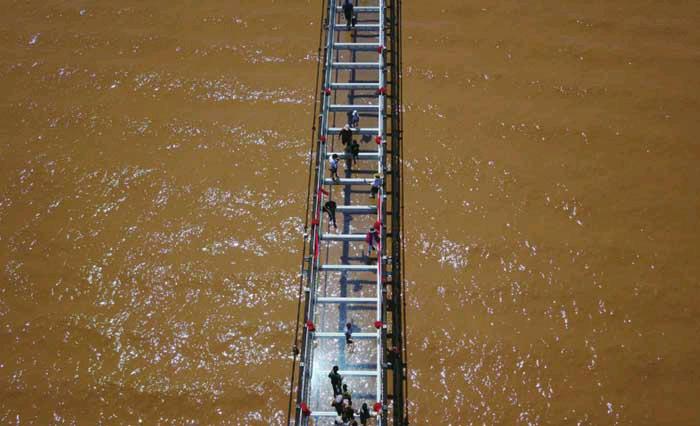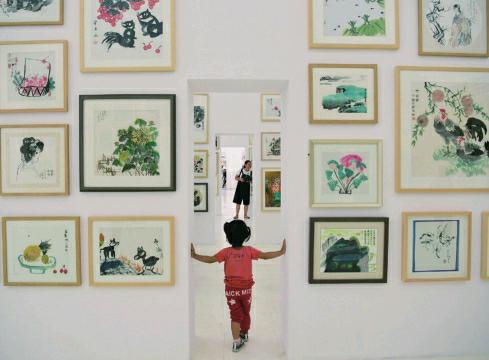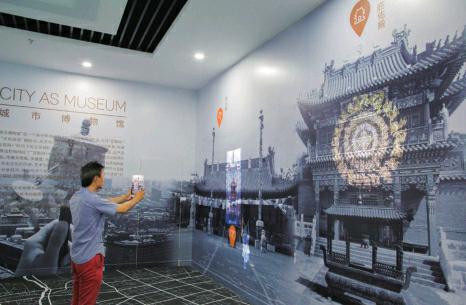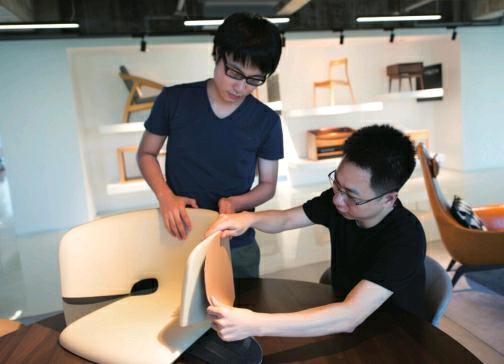Test of Courage
2017-08-16
Tourists walk on a glass bridge across the Yellow River in Zhongwei, northwest Chinas Ningxia Hui Autonomous Region, on August 2. The new attraction was modifi ed from a 210-meter-long suspension bridge by replacing the wooden deck with glass.
Relocation Projects
The National Development and Reform Commission said on July 31 more than 12,000 relocation projects have been started this year to lift people out of poverty.
This involves about 2.8 million people in poverty, with 20 percent of the projects completed by the end of June, the commission said in a statement.
A total of 22 provinces have received relocation funds of more than 260 billion yuan ($38.66 billion), of which 39.36 billion yuan ($5.85 billion) is from the central budget and the rest comes from local government loans, poverty relief funds and central government loans.
Some 3.4 million people will be relocated from poverty-stricken communities to more developed areas in 2017, according to a national plan.
China has vowed to lift all of its poor out of poverty by 2020, with relocation being one aspect of its strategy.
Laxity Punished
More than 4,660 offi cials have been held accountable for their poor environmental protection work after the latest round of inspections, the Ministry of Environmental Protection(MEP) said on August 1.
Over 31,000 cases were highlighted by inspection teams, and 405 people were detained, according to MEP.
It also said while some progress has been made since 2013, common issues were found that require more attention. For example, illegal proj- ects in nature reserves have harmed ecosystems, and environmental protection work in some cities needs to be improved.
A new round of inspections covering eight provincial-level regions will begin soon, MEP announced.
License Priority
China will prioritize the examination of patents in certain fi elds to improve patent licensing effi ciency, the State Intellectual Property Offi ce (SIPO) said on July 31.
According to a set of regulations effective on August 1, applications for and reexamination of patents on energy saving, environmental protection, new-generation information technology, high-end equipment manufacturing, new energy, intelligent manufacturing and some other industries enjoy such treatment.
Patents that involve the Internet, big data, cloud computing and those in sectors with fast evolution of products or technology also have such priority.
“The regulations help form a more comprehensive system for prioritizing patent examinations,”said Song Jianhua, Director of the Treaty and Law Department of SIPO.
Garbage Ban
The customs authority said on August 1 it will work closely with other departments including border defense, coast guard and environmental protection agencies to stop foreign garbage smuggling.
China notifi ed the World Trade Organization in July that it will ban imports of 24 types of solid waste including plastics, unsorted paper, textiles and vanadium slag by the end of 2017.
In the fi rst half of this year, customs seized more than 260,000 tons of smuggled solid waste in 146 cases, according to the General Administration of Customs (GAC).
More than 70 percent of cases since 2013 occurred in the Bohai Rim and the Yangtze and Pearl River deltas, according to GAC spokesperson Zhang Guangzhi.
Solid waste was used as raw material in China to make up for the domestic shortage of resources in the 1980s.
But some companies illegally smuggle foreign garbage into the country for profi t, damaging the environment and public health.
SPC Circuit Courts
The Supreme Peoples Court (SPC) said on July 31 its circuit courts accepted 5,730 cases in the fi rst half of 2017.
The SPC circuit courts are permanent trial courts set up to exercise power on behalf of the SPC. Circuit court judgments and decisions are equal to those made by the SPC.
The work of circuit courts has proven effective in reducing the pub-lic litigation burden and promoting the accessibility of judicial services, said Li Liang, Director of the SPC Trial Management Offi ce.
The SPC currently has six circuit courts, one each in Shenzhen, Shenyang, Nanjing, Zhengzhou, Chongqing and Xian.
World Bank Grant
A fund for seven major cities in China will be allocated by the World Bank to help ease traffi c congestion by reducing the number of private cars on the road and improving public transport.
A total of $32.73 million will be granted to cities including Beijing and Tianjin via the institutions trustfunded program on environmental protection, the Global Environment Facility (GEF).
The international lender said the fund would be used to pilot transit-oriented development (TOD), an urban planning concept that integrates land use and transport.
“It focuses on compact, mixeduse, pedestrian and bicycle-friendly development around transit stations that can help reverse the trend of car-dependent city sprawl, improve air quality and reduce road congestion,” said Fang Wanli, the banks urban economist and project coleader.
The project will facilitate a national TOD platform to help cities strengthen their ability to develop policies, guidelines and strategies for integrated urban planning.
Established in 1991 to help tackle pressing environmental problems, the GEF trust fund has launched 790 investment projects and programs in 120 countries.
Sanjiangyuan Rule
A regulation on the Sanjiangyuan National Park took effect on August 1, aimed at better protecting the headwaters of three major rivers in China.
The regulation bans mining, logging, hunting and fi shing in the national park, which was established in June 2016.
The collection of wildlife bones and eggs without permission within the park is also prohibited, according to the regulation.
Unauthorized scientifi c research, outdoor advertising, and the use of drones are forbidden within the park.
Those who violate the regulation will be fi ned between 1,000 yuan($149) and 200,000 yuan ($29,800).
Sanjiangyuan, which translates as “source of three rivers,” is home to the headwaters of the Yangtze, Yellow and Lancang (Mekong) rivers in northwest Chinas Qinghai Province.
Local provincial legislatures passed the regulation in June.
Atomic Clock
China is developing a new generation atomic clock to be used on the BeiDou Navigation Satellite System, according to China Aerospace Science and Technology Corp. on July 28.
The microwave mercury ion clock is currently one of the most accurate tools for measuring time by tracking atomic movement in the microwave range, said Wang Nuanrang, project leader at the company.
It can provide extremely precise measurements of time that can be used in the fi elds of deep space exploration and satellite navigation.
Wang said scientists will establish an experimental mercury ion clock system to conduct scientifi c tests within the next four years, promoting the development of the BeiDou system.
Since 2012, Chinas self-developed BeiDou system has provided navigation, time and text messaging services in the Asia-Pacifi c region.
By 2020, BeiDou satellites will form a complete global satellite navigation system, according to the China Satellite Navigation System Committee.
Art Fan
A child views pictures during a childrens art exhibition in Xian, capital of northwest Chinas Shaanxi Province, on July 29. More than 2,900 works were displayed at the event.

Digital Reproduction
A staff member uses a tablet computer to demonstrate a product based on augmented reality technology at the iSoftStone Big Data Industry Center in Yuquan District of Hohhot, capital of north Chinas Inner Mongolia Autonomous Region, on August 1.
The facility was put into operation the same day to promote Hohhots efforts to transform itself into a smart city and develop smart tourism programs.
PMI Data
Chinas manufacturing sector expanded for the 12th straight month in July, the National Bureau of Statistics(NBS) said on July 31.
The manufacturing purchasing managers index (PMI) came in at 51.4 in July, down from 51.7 in June, according to NBS data.
A reading above 50 indicates expansion, while a reading below refl ects contraction.
The PMI has remained between 51 and 52 over the past seven months, and the July reading was basically fl at with the average of the fi rst half of the year, said NBS senior statistician Zhao Qinghe.
Zhao attributed the slower expansion to sustained hot weather across China, rainstorms and fl oods in certain regions, and the fact that some companies conducted routine equipment checks and repairs.
Sub-indices for production and new orders came in at 53.5 and 52.8, respectively, down from 54.4 and 53.1 last month, but the narrower gap between them suggested an improved supply and demand relationship, Zhao said.
External demand growth also retreated, with the sub-index for new export orders falling to 50.9 from 52 in June.
The PMI for oil processing and coking as well as the nonmetal mineral products industry stayed below 50 for the third month in a row, affected by overcapacity and restructuring.
Meanwhile, the non-manufacturing sector expanded at a slightly slower pace in July, offi cial data showed.
The non-manufacturing PMI came in at 54.5 in July, down from 54.9 in June, according to the NBS.
Sub-indices for new business orders and activity expectations came in at 51.1 and 61.1, respectively.
The construction industry index continued fast growth, standing at 62.5 in July, compared with 61.4 in June.
“Though at a slower pace, the performance of Chinas nonmanufacturing sector continues to maintain robust momentum,” said Zhao.
Grass Harvest
Farmers drive tractors to harvest grass on a vast pasture in Hami, northwest Chinas Xinjiang Uygur Autonomous Region, on July 31, as part of the preparations for livestock in the following winter.

Guizhous New Airport
The National Development and Reform Commission (NDRC) has approved an airport project in southwest Chinas Guizhou Province, with a total investment of 1.8 billion yuan($267 million).
The airport in Weining Yi Hui and Miao Autonomous County is designed to handle up to 350,000 passengers and 1,050 tons of cargo every year by 2025, according to the NDRC.
Transport infrastructure in Guizhou lags far behind developed areas in China. The project is expected to improve regional transport, enhance emergency response support and boost regional economic development.
China began an airport construction boom in 2008 when the government began massive spending on infrastructure to offset the global fi nancial crisis. By the end of 2015, China had 207 civil airports and the number is expected to reach 260 by 2020.
Monopoly Penalty
The NDRC announced on July 31 that two domestic medicine fi rms had been fi ned for price monopoly practices.
Zhejiang Second Pharma and Tianjin Handewei Pharmaceutical were fi ned a total of 443,900 yuan($65,975) for fi xing prices for an active pharmaceutical ingredient, according to a statement from the NDRC.
The two companies charged an unfairly high price for Isoniazid, an antibiotic used to treat tuberculosis, and declined sales with no justifi ed cause.
The two companies have since restored regular pricing and revived market competition.
Monopoly practices in the pharmaceutical sector have been a focus of Chinas anti-monopoly supervision for some time. The case will help regulate active pharmaceutical ingredient pricing and ensure a fair environment for medicine purchases and sales, according to the NDRC.
Sogou U.S. IPO
Sogou Inc., a Chinese search engine operator, announced on July 31 that it plans to go public in the U.S. stock market.
Its parent company Sohu.com said Sogou will submit paperwork to the U.S. Securities and Exchange Commission this year for a possible initial public offering (IPO). But the company has not disclosed how many U.S. depositary shares would be offered or at what price.
Bloomberg previously reported Sogou may sell 10 percent of its shares and the IPO size will be at$5 billion.
Benefi ting from the announcement, Sohus share price on U.S.-based NASDAQ closed at $56.83, climbing 11.76 percent on July 31.
According to Sohus secondquarter earnings, Sogous revenue hit $211 million in the second quarter of the year, increasing 30 percent year on year.
Currently, Sogous business covers search engine, input method, mapping and smart devices, and its artifi cial intelligence technology is also in development.
In 2010, Alibaba invested $15 million in Sogou and later in 2013, Tencent invested $448 million.
In the Chinese market, the leading search engine operators are Baidu, Sogou and Qihoo 360. Baidu went public on NASDAQ in 2005, and its revenue was $3.08 billion in the second quarter of the year. Qihoo 360 got listed on the New York Stock Exchange in 2011, but fi ve years later, the company got unlisted, and is applying for IPO on Chinas A-share market.
Sitting Pretty
Zhao Lei (right) and his partner Zhang Jingxiang work on a newly designed chair at their startup workshop in Hangzhou, east Chinas Zhejiang Province, on July 28.
With fresh design ideas and good quality, the two mens company has started to win over customers since it was established in 2010.
Airbus China Center
France-based plane-maker Airbus on July 31 said it would set up an innovation and research center in China in order to “support (its) future products and services.”
“The new Airbus innovation center, which is tasked with defi ning the future of fl ight by identifying the next big change to transform the aerospace sector, will serve to strengthen Airbus extended innovation ecosystem,” Airbus said in a press release.
“Chinas fast-paced start-up culture makes it an ideal place for Airbus to create a new innovation center. Growth has come to China from manufacturing, technology and fi nance nowadays,” it added.
The center will offi cially open later in 2017 and the location will be announced at a later date, according to the statement.
Smartest City
Beijing has become the “smartest”city in China, according to a report on cashless societies released on July 31.
The report was jointly published by Chinese tech giant Tencent, the Chongyang Institute for Financial Studies at the Renmin University of China, and French market research fi rm Ipsos.
It measured the level of “smart cities” using different indexes, such as transportation, education, shopping and food delivery, in 324 Chinese cities and polled over 6,500 residents on their use of mobile payments.
Overall, Beijing ranked fi rst in the penetration of a cashless society, followed by Shenzhen, Guangzhou and Shanghai.
The cities of Dongguan and Foshan were the dark horses in the top 10, ranking sixth and 10th, respectively.
The report also showed that 40 percent of Chinese carry less than 100 yuan ($15) in cash when going out, while 52 percent use cash for only 20 percent of their total monthly consumption.
Over 70 percent of respondents said they could live more than a week with only 100 yuan ($15) in cash, and 84 percent were “comfortable” going out with only mobile phones and no cash.
Trash-Turned Treasure
A technician showcases a glass bottle fi lled with enzyme at the laboratory of a biotech company in Chengde, north Chinas Hebei Province, on July 29.
By extracting enzyme from waste straw, companies in Chengde can recycle 30,000 tons of the material per year and the extracted enzyme can be used in sectors including textile, wine making, fruit processing, sewage treatment and oil exploitation.
